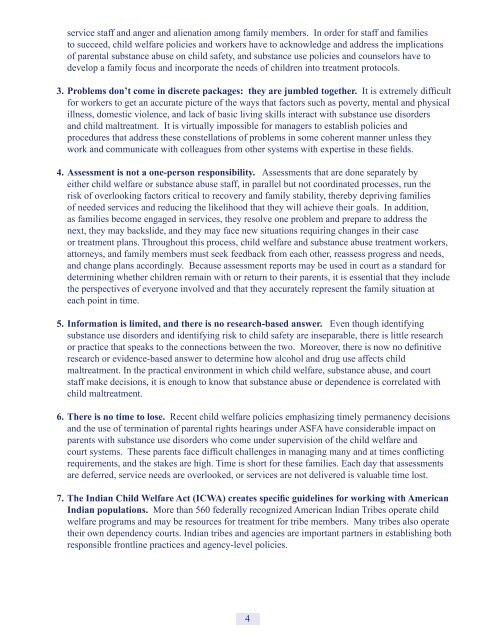Screening and Assessment for Family Engagement, Retention, and ...
Screening and Assessment for Family Engagement, Retention, and ...
Screening and Assessment for Family Engagement, Retention, and ...
Create successful ePaper yourself
Turn your PDF publications into a flip-book with our unique Google optimized e-Paper software.
service staff <strong>and</strong> anger <strong>and</strong> alienation among family members. In order <strong>for</strong> staff <strong>and</strong> families<br />
to succeed, child welfare policies <strong>and</strong> workers have to acknowledge <strong>and</strong> address the implications<br />
of parental substance abuse on child safety, <strong>and</strong> substance use policies <strong>and</strong> counselors have to<br />
develop a family focus <strong>and</strong> incorporate the needs of children into treatment protocols.<br />
3. Problems don’t come in discrete packages: they are jumbled together. It is extremely difficult<br />
<strong>for</strong> workers to get an accurate picture of the ways that factors such as poverty, mental <strong>and</strong> physical<br />
illness, domestic violence, <strong>and</strong> lack of basic living skills interact with substance use disorders<br />
<strong>and</strong> child maltreatment. It is virtually impossible <strong>for</strong> managers to establish policies <strong>and</strong><br />
procedures that address these constellations of problems in some coherent manner unless they<br />
work <strong>and</strong> communicate with colleagues from other systems with expertise in these fields.<br />
4. <strong>Assessment</strong> is not a one-person responsibility. <strong>Assessment</strong>s that are done separately by<br />
either child welfare or substance abuse staff, in parallel but not coordinated processes, run the<br />
risk of overlooking factors critical to recovery <strong>and</strong> family stability, thereby depriving families<br />
of needed services <strong>and</strong> reducing the likelihood that they will achieve their goals. In addition,<br />
as families become engaged in services, they resolve one problem <strong>and</strong> prepare to address the<br />
next, they may backslide, <strong>and</strong> they may face new situations requiring changes in their case<br />
or treatment plans. Throughout this process, child welfare <strong>and</strong> substance abuse treatment workers,<br />
attorneys, <strong>and</strong> family members must seek feedback from each other, reassess progress <strong>and</strong> needs,<br />
<strong>and</strong> change plans accordingly. Because assessment reports may be used in court as a st<strong>and</strong>ard <strong>for</strong><br />
determining whether children remain with or return to their parents, it is essential that they include<br />
the perspectives of everyone involved <strong>and</strong> that they accurately represent the family situation at<br />
each point in time.<br />
5. In<strong>for</strong>mation is limited, <strong>and</strong> there is no research-based answer. Even though identifying<br />
substance use disorders <strong>and</strong> identifying risk to child safety are inseparable, there is little research<br />
or practice that speaks to the connections between the two. Moreover, there is now no definitive<br />
research or evidence-based answer to determine how alcohol <strong>and</strong> drug use affects child<br />
maltreatment. In the practical environment in which child welfare, substance abuse, <strong>and</strong> court<br />
staff make decisions, it is enough to know that substance abuse or dependence is correlated with<br />
child maltreatment.<br />
6. There is no time to lose. Recent child welfare policies emphasizing timely permanency decisions<br />
<strong>and</strong> the use of termination of parental rights hearings under ASFA have considerable impact on<br />
parents with substance use disorders who come under supervision of the child welfare <strong>and</strong><br />
court systems. These parents face difficult challenges in managing many <strong>and</strong> at times conflicting<br />
requirements, <strong>and</strong> the stakes are high. Time is short <strong>for</strong> these families. Each day that assessments<br />
are deferred, service needs are overlooked, or services are not delivered is valuable time lost.<br />
7. The Indian Child Welfare Act (ICWA) creates specific guidelines <strong>for</strong> working with American<br />
Indian populations. More than 560 federally recognized American Indian Tribes operate child<br />
welfare programs <strong>and</strong> may be resources <strong>for</strong> treatment <strong>for</strong> tribe members. Many tribes also operate<br />
their own dependency courts. Indian tribes <strong>and</strong> agencies are important partners in establishing both<br />
responsible frontline practices <strong>and</strong> agency-level policies.<br />
4


